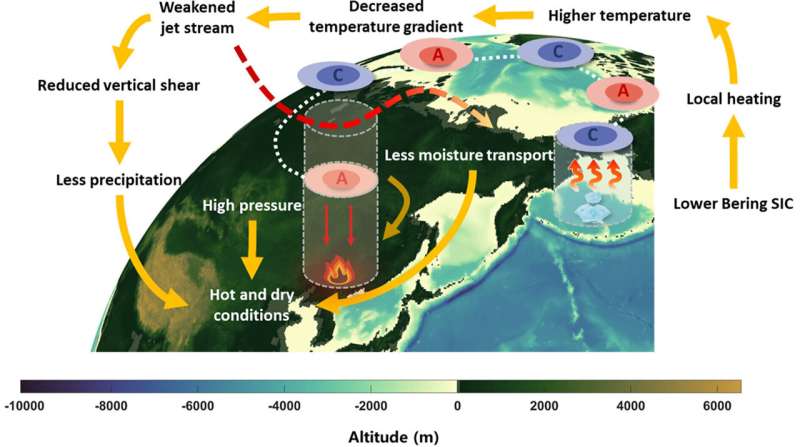
Schematic diagram of the effect of Bering Sea ice decline on wildfire occurrence in northeast China. Credit: Geophysical Research Letters (2023). DOI: 10.1029/2023GL105931
China has been making strides in recent years to reduce air pollution, including fitting filters in coal-fired power stations to remove sulfur dioxide from emissions, a molecule that reacts with other compounds in the atmosphere to form polluting particulates. The country’s Air Pollution Control Act also aims to tackle pollution from manufacturing, vehicles and agriculture, alongside intending to become carbon neutral by 2060.
However, in contrast to this, the northeast of China (120°E–135°E and 40°N–50°N) has experienced an upsurge in polluting emissions from natural and anthropogenic-induced wildfires and the resulting biomass burning over the last decade, accounting for approximately 60% of total burned area in the country. This region possesses some of the greatest and most diverse tree coverage in China, meaning it is a critical natural ecosystem and resource under threat.
The cause of these wildfires is the focus of new research published in Geophysical Research Letters, which links a decline in sea ice moving from the Arctic to the Bering Sea, north Pacific Ocean (160°E–158°W, 53°N–66°N), to increased occurrence of fires during boreal spring (March, April and May).
Guanyu Liu and colleagues from Peking University, China, used climate model simulations alongside real observational data to understand this link and identify fire hazard intensification as this pattern amplifies with continued global warming. The research team used meteorological data from the past 40 years to understand weather changes conducive to wildfire events, alongside data of smoke concentrations and fire radiative power.
Modeling identified a one-month lag between disruption to Bering Sea ice and the presence of wildfires, which the scientists suggest may be impacted by ice albedo feedbacks. This occurs when radiative forcing from the sun is either reflected by “white” ice, or absorbed by the surrounding comparatively “dark” sea water. In the latter case, this causes the ambient environment to warm, resulting in further melting of sea ice and absorption of solar radiation, generating a feedback loop that continuously progresses the decline of sea ice.
Predictions of Bering Sea ice concentration decline (a) and northeast China wildfire increase (b) under different radiative forcing climate scenarios up to 2100. Credit: Geophysical Research Letters (2023). DOI: 10.1029/2023GL105931
A weakened temperature gradient between the Arctic and lower latitudes encourages a reduced polar and subtropical jet stream and consequently weakened wind shear (the change in horizontal wind direction/speed with height). Thus, this reduces vertical atmospheric convection above northeast China, making the formation of clouds less likely, and therefore the possibility of precipitation.
In the computed experiments, Liu and colleagues found that sea ice decline during winter leads to decreased precipitation and warmer temperatures in northeast China, affected by unusual higher-speed northwesterly wind patterns and the formation of high-pressure centers with downward-directed airflow. As such, they suggest this creates a tinderbox of hot, dry conditions ready to ignite at any moment and spread rapidly via strong wind regimes.
Such conditions are further exacerbated by global-scale climate patterns, such as the El-Niño Southern Oscillation and Pacific Decadal Oscillation, atmosphere-ocean interactions impacted by sea surface temperature in the Pacific Ocean. Both of these climate oscillations encourage drought during their warm positive phases and therefore heighten the potential for wildfire occurrence.
Translating this knowledge to future predictions under the most extreme climate scenario of Shared Socioeconomic Pathway 8.5 (SSP585), where radiative forcing increases by 8.5W/m2 by 2100, the research team identified a clear pattern of continued Bering Sea ice decline and the occurrence of more wildfires in northeast China. For the lower radiative forcing of 7W/m2 (SSP370), wildfire occurrence was still higher than what has occurred over historical measurements, but the pattern is less distinct for the lowest radiative forcings of 2.67W/m2 (SSP126) and 4.57W/m2 (SSP245).
With Arctic sea ice concentration predicted to disappear entirely during summer months by the 2050s, the likelihood of more frequent and damaging wildfires is an ever-pressing issue that requires management strategies to be implemented as soon as possible, no matter the level of climate change forcing.
More information:
Guanyu Liu et al, Increasing Fire Weather Potential Over Northeast China Linked to Declining Bering Sea Ice, Geophysical Research Letters (2023). DOI: 10.1029/2023GL105931
© 2023 Science X Network
Citation:
Declining Bering Sea ice linked to increasing wildfire hazard in northeast China (2023, October 24)
retrieved 24 October 2023
from https://phys.org/news/2023-10-declining-bering-sea-ice-linked.html
This document is subject to copyright. Apart from any fair dealing for the purpose of private study or research, no
part may be reproduced without the written permission. The content is provided for information purposes only.
>>> Read full article>>>
Copyright for syndicated content belongs to the linked Source : Phys.org – https://phys.org/news/2023-10-declining-bering-sea-ice-linked.html
